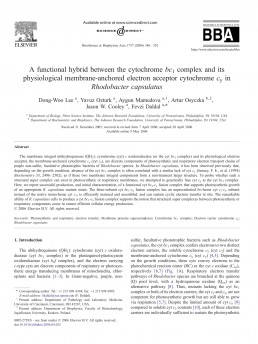Click the link above for more details.
A functional hybrid between the cytochrome bc1 complex and its physiological membrane-anchored electron acceptor cytochrome cy in Rhodobacter capsulatus
Abstract
The membrane integral ubihydroquinone (QH2): cytochrome (cyt) c oxidoreductase (or the cyt bc1 complex) and its physiological electron acceptor, the membrane-anchored cytochrome cy (cyt cy), are discrete components of photosynthetic and respiratory electron transport chains of purple non-sulfur, facultative phototrophic bacteria of Rhodobacter species. In Rhodobacter capsulatus, it has been observed previously that, depending on the growth condition, absence of the cyt bc1 complex is often correlated with a similar lack of cyt cy (Jenney, F. E., et al. (1994) Biochemistry 33, 2496–2502), as if these two membrane integral components form a non-transient larger structure. To probe whether such a structural super complex can exist in photosynthetic or respiratory membranes, we attempted to genetically fuse cyt cy to the cyt bc1 complex. Here, we report successful production, and initial characterization, of a functional cyt bc1-cy fusion complex that supports photosynthetic growth of an appropriate R. capsulatus mutant strain. The three-subunit cyt bc1-cy fusion complex has an unprecedented bis-heme cyt c1-cy subunit instead of the native mono-heme cyt c1, is efficiently matured and assembled, and can sustain cyclic electron transfer in situ. The remarkable ability of R. capsulatus cells to produce a cyt bc1-cy fusion complex supports the notion that structural super complexes between photosynthetic or respiratory components occur to ensure efficient cellular energy production.
CategoryPeer-reviewed PublicationsDate2006.05Linkwww.ncbi.nlm.nih.gov
